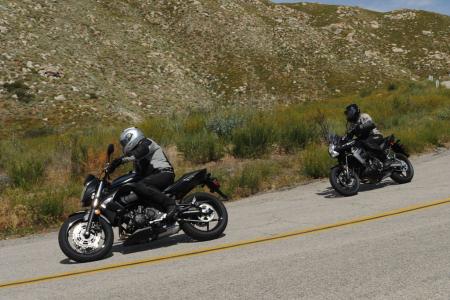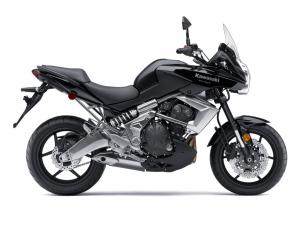Since its introduction four years ago, some have grappled with defining this competent but somewhat ambiguous 649cc parallel-Twin all-round sport motorcycle, which even Kawasaki once listed on its website under “Dual Purpose।”
Its name is contrived from the words “versatile” and “system,” and offers some clues.
The Versys takes elements from dual-purpose bikes, standards, adventure-tourers and sportbikes; sharing characteristics of all, but neatly fitting into the category of none.
In fact, it is essentially a longer-travel ER-6n, albeit with a more sophisticated inverted fork, an asymmetrical “gullwing” aluminum swingarm, retuned engine for broad midrange power, and with unique looks.
The Versys and ER-6n also share many features with their fraternal-triplet sibling, the Ninja 650R. But while the Ninja 650R and ER-6n have identical, peakier versions of the same engine, the Versys has revised intake and exhaust cams, a 10.6:1 compression ratio instead of 11.3:1, and redline set 500 rpm lower at 10,500. 
While officially considered a “worldwide bike,” the Versys was designed first for the European and Canadian markets, and launched there in 2006. Then after many requests from U.S. riders, Kawasaki brought it in, at first as a 49-state 2008 model. California got its Versys in 2009, when a required evaporative emissions canister was fitted.
Even so, the bike is still much better appreciated in Europe, as evidenced by its sales performance. “We also have to realize that the lion's share of Versys are purchased in Europe where they understand and embrace this type of motorcycle and where it is ridden enthusiastically,” says Kawasaki’s Public Relations Supervisor, Russ Brenan.
The American motorcycle press never underappeciated the Versys, however, and some publications loaded it with accolades, saying it is well suited for anyone, be they new or experienced or somewhere in between.
This leads us to wonder whether this hearty and unanimous recommendation was received just like a lot of advice so often is from an experienced elder – disregarded by the kids who know better! To wit, Kawasaki says 64% of U.S. Versys purchasers are age 45 and older, and 62% have more than five years riding experience. In contrast, riders under age 25 comprise just 2% of U.S. Versys buyers, and those age 25 to 34 represent a mere 8%.
We might euphemistically attribute this to different priorities between younger U.S. riders and their European counterparts, including possible objections over its “funky” appearance. But whether its looks will enhance the image you think you represent, or not, the Versys is aptly named. Its is good at nearly any kind of on-road riding you can throw at it – from grocery getting, to commuting, to sport riding, to exploring even the roughest of roads nearby, or on tour.
Plastic Surgery
This year’s model received mostly stylistic bodywork tweaks, which while subtle, are not few.
The Versys’ face is as distinctive as ever, now with dual stacked headlights. Its semi-double-cradle, high-tensile steel frame is adorned with new plastic, ranging from a re-sculpted fairing, radiator shroud, engine covers and rear fender.
Blocking the wind is a bigger three-way adjustable windscreen which protects the rider surprisingly well. Kawasaki also offers a “Tall Windshield” for $159.95, and a “Vario Windshield” with a wider, taller base, and adjustable spoiler for $199.95.
This year, new mirrors, turn signals and an LED tail light from the Z1000 are also included.
The counterbalanced engine is reasonably smooth, but rigid rear engine mounts were replaced with rubber mounts, and the footpegs now utilize hollow rubber inserts to further quell vibration.
That combined with satisfying around-town usage lead us to agree with Brenan, who says, the Versys is, "the bike that most riders don't know they've always wanted."
Or, as Kawasaki’s Sr. Media Relations Coordinator, Jeff Herzog says, “It's similar to the Z1000. You have to ride it to understand it and find out how much fun can be had on one.”
fun can be had on one.”
Sure, these guys want to sell motorcycles, but they speak the truth.
Kawasaki now correctly calls the Versys a “sport” bike. As such, it does not readily run out of cornering clearance, despite respectable grip from the stock Dunlop D221 Sportmax rubber, and its wide handlebar aids and abets riders to snap it into corners.
If the road turns rough, the Versys suspension inspires more confidence than its ostensibly more sporting stablemates.
Out back its offset laydown Showa shock provides 5.7 inches of travel, compared to the Ninja 650R or ER-6n’s 4.9 inches. All three bikes offer stepped spring preload adjustment, but the Versys adds 13-position adjustable rebound.
Up front is a likewise longer inverted 41mm fork cycling through 5.9 inches of travel, and offering stepless adjustable rebound and preload, compared to the Ninja 650R’s or ER-6n’s basic non-adjustable 4.7 inch standard hydraulic fork.
The Versys’ front and rear spring rates are progressive. The result is an initially soft and very compliant feel over stutter bumps, chewed up pavement, or patched and seamed sections of roads. But when speeds get competitive, the spring rates firm up, and the bike feels planted and secure.
Ortlieb Motorcycle Luggage Review
Their design may not include outside pockets for you to lose your do-dads in, but that’s what small extra bags are for. And when the going gets tough, these large-volume primary bags are otherwise hard to beat.
For example, if you’ve ever had ordinary coated pack cloth bags and gotten caught in the rain, you may know how easy it is to get water into your clothes, gear, and anything else you might have packed.
Ortlieb’s Euro-designed bags prevent this by using the time-honored method that whitewater kayakers and their ilk use to keep their stuff dry. They are made of tough waterproof coated fabrics specially designed to Ortlieb’s specs, and assembled using a high frequency welding process. The bags are highly effective and have a solid reputation among serious outdoor travelers of all sorts. They resist water infiltration by having no zippers to leak, and only one opening per bag – which closes utilizing the roll-top method to make them air-tight to the point that they could float if they had to.
They are made to resist up to 100,000 folds (to the roll-top), and meet stringent engineering criteria Ortlieb sets for water-tightness, tear and abrasion resistance. Assuming you roll them closed correctly, any splashed or falling water should have no effect on their dryness-factor, and this means rain covers are unnecessary. As experienced riders may know, rain covers can leak, blow off, or get lost. It was a relief for us not to have to deal with them.

